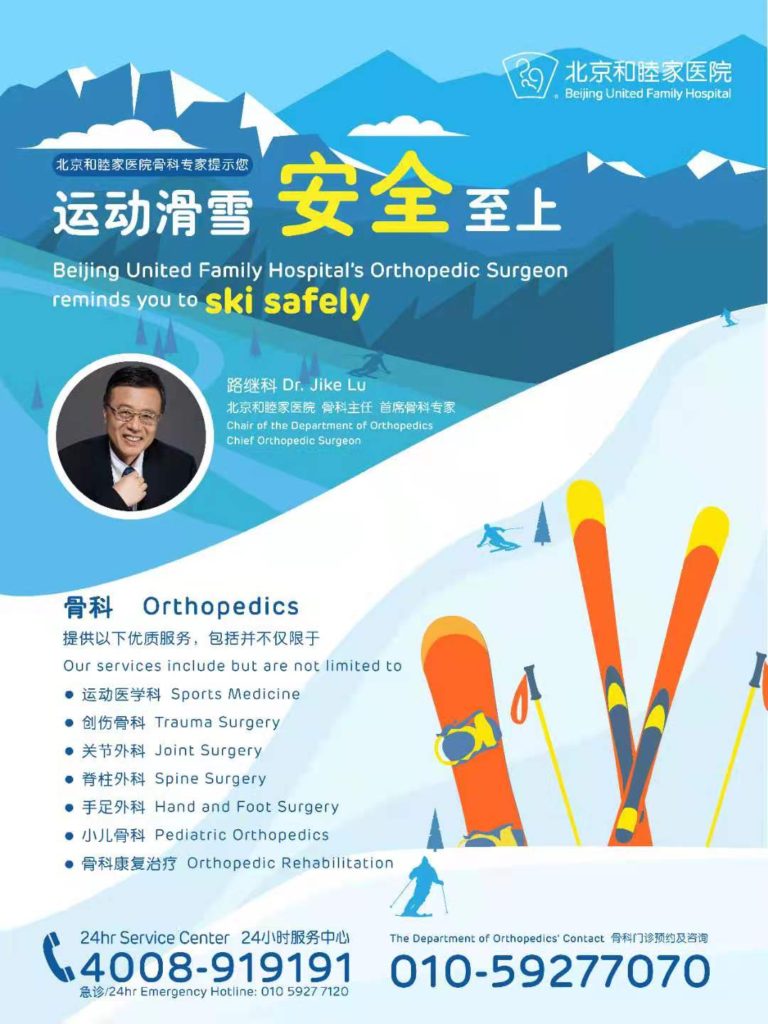
Doctor’s Tips for the Skiing Season – How to Avoid Injuries
Alpine skiing is gaining enormous popularity in China and the present reported number of 1.2 million skiers will further increase with the Beijing Winter Olympics in 2022 around the corner. Skiing is a fantastic sport and a great way to enjoy the outdoors. However, with the growing number of skiers and the always-changing styles and equipment, the technical and physical demand is constantly growing as well. This has resulted in a significant increase of winter-sports-related injuries in ski resorts around the world.
The overall risk of sustaining an injury during skiing or snowboarding can be reduced by following a targeted fitness program. Muscles are important when it comes to protecting joints and ligaments and need to be properly prepared to minimize the risk of injury. Here to explain how to do just that is Beijing United Family Hospital (BJU) Orthopedic Surgeon, Dr. Jike Lu.
Get your body ready
Regardless of your fitness level, you should start preparing your body for skiing at least six weeks in advance. You can do that by joining special fitness classes in your gym, by hiring a personal trainer, or doing a work out by yourself. I recommend working on your endurance, strength, and coordination at least twice a week.
One example of a suggested workout:
– Warm-up (including stability and coordination exercises)
– Endurance (running or cycling)
– Strengthening
– Stretching and cool down
Carving skis and snowboards
The newer generation of carving skiing and snowboarding requires more technical skills of winter sports enthusiasts. I have very often seen beginners who use this modern and quite aggressive skiing equipment sustain severe and devastating injuries that could have easily been prevented. Therefore, I advise getting some professional instruction, especially when you are not used to this modern material. Even one day of carving instruction may help to reduce risk of injury and make the experience more enjoyable. The same applies to those new to snowboarding. A beginner’s course always pays off. Without some of the simple basic skills, you may end up falling down all the time and getting frustrated and quitting before you even get a chance to get started.
Before going downhill
A proper warm-up reduces the number of injuries. This can already be started on the way up or on top of the mountain. A simple 10-minute warm-up including range-of-motion and flexibility exercises seems appropriate. Starting cold means exposing your muscles and joints to unnecessary risk. In my practice, I have treated hundreds of patients whose skiing day only lasted about 10 minutes or even less. For the majority of these people, a simple fall or turn resulted in an otherwise easily avoidable injury.
If you watch a ski race on television, you can see how seriously professional athletes take their warm-ups. The first run of the day should always be an easy one to allow you to get used to the slopes and the type of snow. For example, a soggy type of snow on warmer days acts entirely different compared to a dry powder type of snow on colder days. Once you feel comfortable, you can increase the difficulty level of the slopes you are skiing.

Additional tips from the expert
Using the wrong equipment significantly increases the risk of accidents. Consequently, you may not only suffer from severe injuries – you will also not be able to enjoy this fantastic sport. Your body mass and height are not the deciding factors for the right choice of equipment; this decision is purely made by the level of your skiing ability. In addition, it is important to get your skis and bindings regularly checked before hitting the slopes.
The Department of Orthopedics’ Sports Medicine Specialty
The Department of Orthopedics’ Sports Medicine Specialty uses minimally invasive arthroscopy or arthroscopic-assisted techniques to diagnose, treat, and rehabilitate various joint injuries and diseases. We also cooperate with many well-known domestic experts, such as Peking University People’s Hospital, Peking University Third Hospital, and Jishuitan Hospital to carry out minimally invasive surgery for the shoulders, hips, knees, elbows, ankles, and wrists.
Our services include but are not limited to:
• Acute/chronic sports injury
• Injury of the extremities/joints/ligaments/tendons
• Meniscus injury
• Cruciate ligament injury
• Rotator cuff injury
• Labrum injury
• Triangular fibrocartilage complex injury
• Achilles tendon injury
Copyright United Family Healthcare 2014 All right reserved - 京卫网审[2014]第1927号 - 京ICP备13017554号-4








